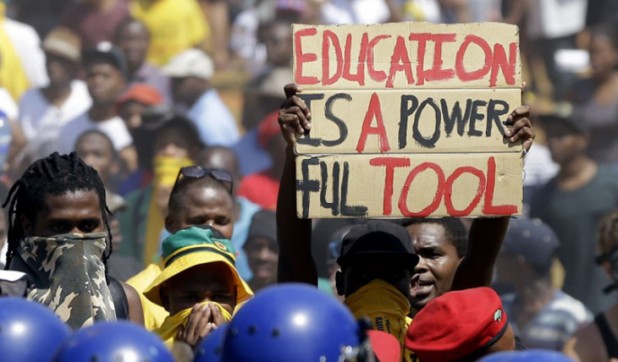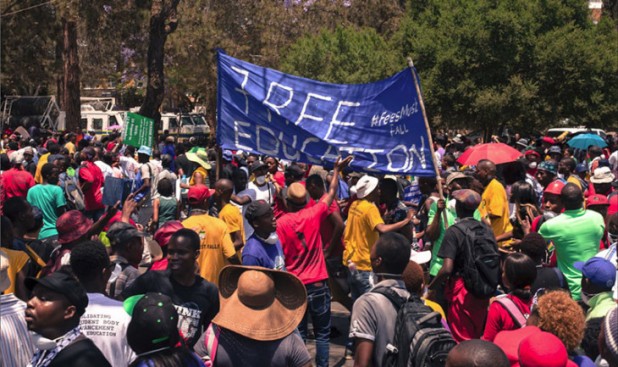The New Observer
November 1, 2015
More than 85% of all undergraduate students enrolled at South Africa’s majority black 23 public universities fail their studies and drop out, according to a report by that country’s government. The failure rate for Master’s students is 80 percent and for doctoral students 88 percent.
These figures were contained in the South African Government’s Department of Higher Education and Training’s annual statistical report which looked at the “size and shape of post-school education and training in South Africa.”
The pass rates in South Africa have been steadily falling for several years, according to local media. Nicolene Murdoch, the executive director for teaching and quality at Monash University in South Africa, was quoted as saying that the graduation rates have ranged from 15 percent to 20 percent for several years now.
Black students are the overwhelming majority of students in South Africa—some 78 percent of what are called “contact students” (those on campus) and 83 percent of all students enrolled in distance education. Student registrations have increased every year, from 495,355 in 1994 to 1,002,110 in 2014.
The pass rate is, not surprisingly, even lower than the school graduation rate in that country. Although the official pass rate in 2014 was 75.8 percent, this is a highly deceptive—and typically Third World ruse.
To “pass” end of school examinations in South Africa, a student only needs to get 40 percent in three subjects—one of which must be their home language—and 30 percent in three other subjects.
Technically speaking, if a pupil met the minimum requirements and obtained 40 percent for three subjects, 30 percent for three subjects and 0 percent for a seventh subject, then then they would pass with a 30 percent average.
In reality, they are unlikely to get exactly those scores, but in practice this means that anyone who gets around 35 percent overall can “pass” their final exams and obtain a school-leaving certificate (called “matric”) in South Africa.
A further flaw in using the matric pass rate as a barometer of national performance is that thousands of school pupils drop out long before they reach their final year. The dropout rate is not taken into account in the final pass rate.
For example, when the 2013 matric class started grade one in 2002, there were 1,261,827 pupils. But by the time they came to sit for their final exams, their numbers had fallen to 562,112.
A press statement on the matter released by the conservative Transvaal Agricultural Union (Transvaalse Landbou-unie, TLU) in Pretoria, added the following thoughts:
The state allocates R9 billion a year to student subsidies, while operating subsidies to the country’s 26 universities total R72 billion over three years. One can imagine the huge loss incurred because of the 800,000 students who didn’t make it in 2014, let alone the hundreds of thousands who dropped out over the past twenty odd years. What has become of them?
South Africa’s economic structure is one of the most warped in the world. Thirteen percent of South Africa’s 53 million people pay income tax, while 36 percent of the country’s budget is allocated to wages for a bloated public service whose lack of capacity has led to the birth of a parallel privately-funded service industry that has expanded in direct proportion to the dissipation of government services in, inter alia, the security, schooling, postal, and health sectors.
South Africans thus pay twice for services, while the small tax base foots the bill for 15 million welfare recipients and the billions lost through government corruption and inefficiency.
There is no shortage of grandiose government plans, many based on ideology and hot air. No thought to the cost is given. The government’s National Development Plan sees 10 million people obtaining bachelor’s degrees by 2030, surely pie in the sky especially in the face of the government’s current penurious economic plight that has resulted in riots, destruction and scholar disappointment.
Where will the money come from to foot the looming tertiary education bill? The cookie jar is dangerously low. Since 2007, South Africa has accumulated the most debt as a percentage of GDP of the 14 emerging markets monitored by the Bank for International Settlements (BIS).
What the TLU statement did not point out, however, is that even if the South African government did have the money to pay for “10 million Bachelor’s degrees” by 2030, no amount of cash in the world will correct the fact that the IQ score in sub-Saharan Africa varies between 59 and 74—a level at which any sort of education, training, advancement, or technology is simply impossible.


